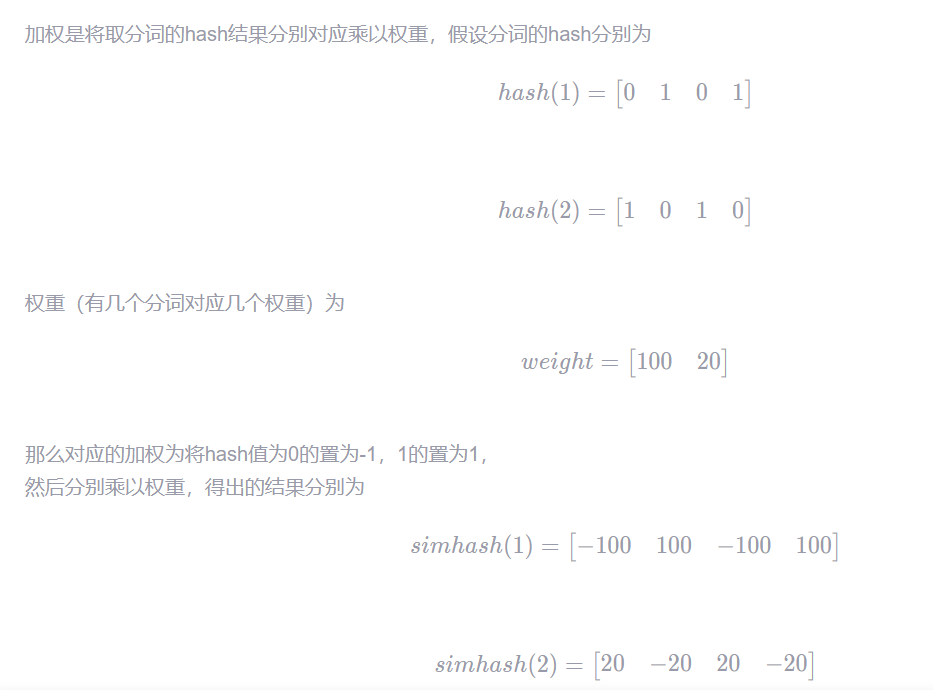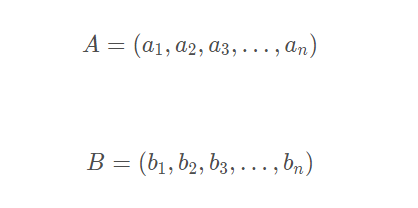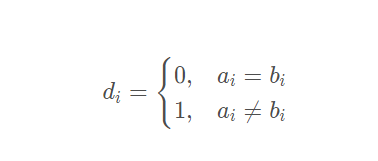您好,登錄后才能下訂單哦!
您好,登錄后才能下訂單哦!
這篇文章主要介紹python如何實現Simhash算法,文中介紹的非常詳細,具有一定的參考價值,感興趣的小伙伴們一定要看完!
simhash包含分詞、hash、加權、合并、降維五大步驟
simhash代碼如下:
import jieba
import jieba.analyse
import numpy as np
class SimHash(object):
def simHash(self, content):
seg = jieba.cut(content)
# jieba.analyse.set_stop_words('stopword.txt')
# jieba基于TF-IDF提取關鍵詞
keyWords = jieba.analyse.extract_tags("|".join(seg), topK=10, withWeight=True)
keyList = []
for feature, weight in keyWords:
# print('feature:' + feature)
print('weight: {}'.format(weight))
# weight = math.ceil(weight)
weight = int(weight)
binstr = self.string_hash(feature)
print('feature: %s , string_hash %s' % (feature, binstr))
temp = []
for c in binstr:
if (c == '1'):
temp.append(weight)
else:
temp.append(-weight)
keyList.append(temp)
listSum = np.sum(np.array(keyList), axis=0)
if (keyList == []):
return '00'
simhash = ''
for i in listSum:
if (i > 0):
simhash = simhash + '1'
else:
simhash = simhash + '0'
return simhash
def string_hash(self, source):
if source == "":
return 0
else:
temp = source[0]
temp1 = ord(temp)
x = ord(source[0]) << 7
m = 1000003
mask = 2 ** 128 - 1
for c in source:
x = ((x * m) ^ ord(c)) & mask
x ^= len(source)
if x == -1:
x = -2
x = bin(x).replace('0b', '').zfill(64)[-64:]
return str(x)
def getDistance(self, hashstr1, hashstr2):
'''
計算兩個simhash的漢明距離
'''
length = 0
for index, char in enumerate(hashstr1):
if char == hashstr2[index]:
continue
else:
length += 1
return length分詞是將文本文檔進行分割成不同的詞組,比如詞1為:今天星期四,詞2為:今天星期五
得出分詞結果為【今天,星期四】【今天,星期五】
hash是將分詞結果取hash值
星期四hash為:0010001100100000101001101010000000101111011010010001100011011110
今天hash為:0010001111010100010011110001110010100011110111111011001011110101
星期五hash為:0010001100100000101001101010000000101111011010010000000010010001


降維是將合并的結果進行降維,如果值大于0,則置為1小于0 則置為0,因此得到的結果為:

一般simhash采用海明距離來進行計算相似度,海明距離計算如下:
對于A,B兩個n維二進制數

二者的海明距離為:

其中:

舉例:
1000與1111的海明距離為3
以上是“python如何實現Simhash算法”這篇文章的所有內容,感謝各位的閱讀!希望分享的內容對大家有幫助,更多相關知識,歡迎關注億速云行業資訊頻道!
免責聲明:本站發布的內容(圖片、視頻和文字)以原創、轉載和分享為主,文章觀點不代表本網站立場,如果涉及侵權請聯系站長郵箱:is@yisu.com進行舉報,并提供相關證據,一經查實,將立刻刪除涉嫌侵權內容。